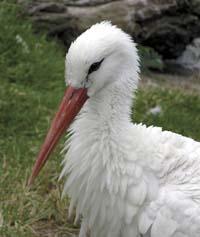The Osprey Returns
2009/10/01 Rementeria Argote, Nagore - Elhuyar Zientziaren Komunikazioa Iturria: Elhuyar aldizkaria
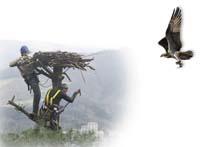
"Logie was special because it gave a lot of information," says Galarza, "for the first time we knew what the osprey was doing in Urdaibai." In fact, Logie wore a satellite transmitter that allowed him to know in detail his travels.
The idea of recovering the osprey came in Urdaibai after Logie's stay. In the passage it seems that the osprey is quite common on the Basque coast, and not only that: "It seems," says Galarzak-, a couple who was about four years ago, it seemed that they would take root there, in Urdaibai, but it was not so." For these cases, four artificial nests have been installed this summer, at the initiative of the Urdaibai Foundation and with the collaboration of the Provincial Council of Bizkaia: holm oak and marsh, three at the tip of the high pines and a fourth on a pole.
According to Galarza, "the osprey is a semi-colonial eagle and if you see an appropriate place -- and it is an ideal place if there are other couples in that area -- that is, if you see that there are nests, you think that also for them is an appropriate place to reproduce, and maybe some young man is [never raised] in Urdaibai. The distribution areas are gradually expanding, like an oil stain, suddenly no new core appears in a remote place." This is taken into account in reintroduction programs, as it depends on the biology of the osprey.
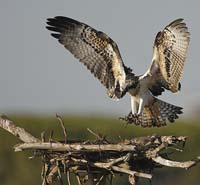
Scottish work as an example
Members of the Urdaibai Foundation addressed Roy Dennis, an expert on the restoration of the osprey. Dennis Highland is the founder of the Foundation for Wildlife foundation, whose work and advice have enabled the recovery of the osprey in different parts of the UK, among others. The work done in Scotland, for example, is used as a model. In 1916 there was no pair left, it disappeared, but in 1954 a couple nested and the population of the osprey began to grow. In 2001 reintroduction programs were initiated. According to Rafa Saiz, president of the Itsas Enara Ornithological Association, "the work carried out in the area has made more than 200 couples today." Logie was a member of that colony.
In Scotland, chickens from abroad grew from northern Europe and the Baltic. According to Saiz, "the bastion of the European population is in the north, especially in Finland, Scandinavia and the Baltic countries." For the adaptation of chickens to their new residence was used the technique of hacking, which consists of the semi-free growth of chickens, nests in the forest, but surrounded by a net to protect chickens, which feed on a hole to prevent food from being associated with man. All this so that the txite can believe that the place where it has been reintroduced is its place of birth. In fact, the osprey is closely linked to the place of birth: it migrates south (towards August-September, to several territories of Africa), two or three years ago, and returns to the place of birth in spring to look for the nest and form a couple, from that moment it will migrate annually and return to its breeding to the same place. Therefore, if you want to reintroduce the osprey in one place, the most effective strategy is to make the Chinese believe that he was born there. For Galarza, "it's the safest way to get a reproductive core."
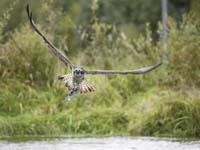
This is the strategy that has been followed to introduce the osprey in Andalusia, and after seven years of effort, this year two couples have formed: After 50 years five chickens were born for the first time in Cadiz and Huelva, the Barbat reservoir and the Odiel river marsh. Eva Casado is coordinator of the osprey and the reintroduction of the solar eagle in Andalusia: "In our case, we brought the chickens from Scotland, Germany and Finland. Until last year they were 108 and this year we brought 27. Thus, we have brought to Andalusia a total of 135 chits in seven years."
It has been a great job, but Casado believes it has been worth it and disagrees with those who say it is excessive intervention: "The argument they use is that we have to leave nature in peace. That would be ideal, but we have not left nature in peace since man is human. So, if human intervention has caused the disappearance of species by habitat destruction, forest clearing, the drying of lagoons… it is too late to say that we will not intervene. In addition, each case is particular."
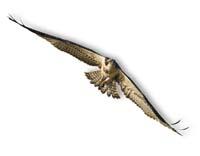
In the case of the osprey, a study of the growth of the European population was conducted. "We made an estimate of the time it would take for this species to breed in northern Europe to reach the Iberian Peninsula and which, at best, would take 150 years." Then it was decided that it was necessary to intervene so that the osprey returned to Andalusia.
Lack of historical records
Casado claims that habitat extinction was the cause of the disappearance of the osprey in Andalusia. "It has not been shown because it is very difficult to obtain data from the time. But the decline of the osprey took place in the 1960s, when it was the boom of the second home, when urbanisations and large hotels began to be built on the coast. And this species is raised on the coast at that time."
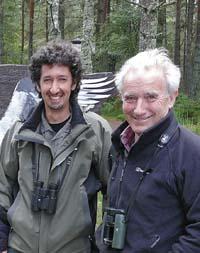
However, it would not be surprising that the osprey disappeared due to human activities. "The nest of the osprey is very easy to see," says Galarza, "and fishing, so it is a competitor for humans. That is why his disappearance is normal and has remained in very distant places". He is used to living in very quiet places.
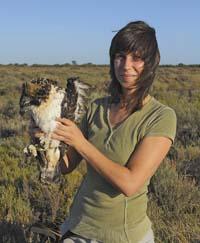
In that sense, Galarza is the one that most doubts has, since Urdaibai is not a very quiet place, "there are people where there are, the engines arrive anywhere...". Moreover, from a food point of view, Urdaibai is a very appropriate place. And so it seemed to Roy Dennis on his visit a year ago. In his blog he collected what he saw: "We have visited all the locations of Logie in the estuary and with its ornithologists we have discussed whether the coast is suitable for the osprey. It is incredible the heap of corks that are in the estuaries and coasts, so it is very easy to find food for the osprey. At this time there is a female osprey in the estuary and I have seen a young man in a smaller estuary, and further west, in a large estuary, there were at least three in migration, two of them eating corcon."
Anyway, Galarza has her feet on the ground. "It won't be easy. I just met the forest population of Orleans and was with some friends from Lorraine: This year they have grown for the first time along the Moselle River and are ten years of nesting." Therefore, they expect long-term results, unless they implement an intervention plan like the Andalusian. "We do not rule out reinsertion, but it is very complicated and we have to reach an agreement between administration and citizenship. We'll see."

Gai honi buruzko eduki gehiago
Elhuyarrek garatutako teknologia




